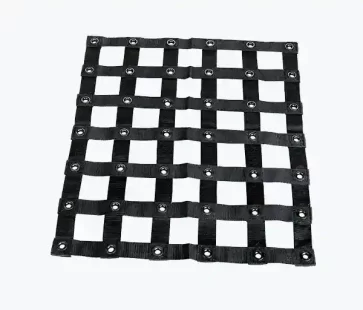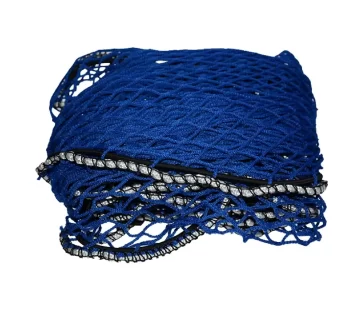Cargo Nets: The Ultimate Guide to Secure Transportation
Introduction to Cargo Nets
A cargo net is a super helpful tool for keeping cargo safe on trucks and trailers. Instead of using lots of separate straps that take forever to set up, you just use this net, which has a grid pattern. It saves you time and makes it easier to secure small stuff. Cargo nets work for all kinds of cargo and make sure everything stays put while you’re driving. The cool thing about cargo nets is that they’re made with this grid pattern, which makes them super strong and helps keep everything in place. Plus, because of this grid design, you can easily secure smaller items without worrying about them slipping through the cracks. So, whether you’re moving furniture or taking your bikes on a road trip, a cargo net is a lifesaver. It’s simple, it’s quick, and it gets the job done right.
Elastic Cargo Net vs. Elastic Cargo Nets
When it comes to securing cargo, the choice between non-elastic and elastic cargo nets plays a importatn role in transportation safety and efficiency. This section delves into the characteristics, advantages, and considerations of both types to help you select the most suitable option for your specific needs.
Elastic Cargo Nets
Elastic cargo nets are known for their flexibility and adaptability, making them an excellent choice for securing irregularly shaped items or loads that may shift during transit. These nets are typically made from materials with high elasticity, such as rubber or elasticized synthetic fibers, allowing them to stretch over cargo and snugly secure it in place.
Advantages of Elastic Cargo Nets:
Flexibility: Their ability to stretch accommodates various shapes and sizes of cargo, providing a snug fit and preventing movement.
Ease of Use: Elastic nets can be quickly and easily applied or removed, saving time during loading and unloading.
Versatility: They are suitable for a wide range of applications, from small personal vehicles to larger commercial transport.
Considerations for Elastic Cargo Nets:
Load Type: Best for lighter, less bulky items that benefit from the give-and-take of elastic support.
Durability: While highly flexible, they may not withstand the rigors associated with very heavy or sharp-edged cargo.
Non-Elastic Cargo Nets
Non-elastic cargo nets, on the other hand, are designed to offer stability and strength for heavier loads. Made from materials like nylon, polyester, or polypropylene, these nets lack the stretchability of their elastic counterparts but provide superior resistance and security for bulky, heavy cargo.
Advantages of Non-Elastic Cargo Nets:
Strength: They can securely hold heavier loads in place, making them ideal for industrial and commercial use.
Durability: Constructed from tough, wear-resistant materials, non-elastic nets are more suited to heavy-duty applications and harsh conditions.
Security: Provides a stable, immovable barrier against cargo movement, essential for long-distance transportation and rough terrains.
Considerations for Non-Elastic Cargo Nets:
Flexibility: Without the ability to stretch, these nets might not accommodate irregular loads as effectively as elastic nets.
Application: Requires careful selection to match the net’s size and mesh dimensions with the cargo’s specific dimensions and weight.
Choosing Between Elastic and Non-Elastic Cargo Nets:
The choice between elastic and non-elastic cargo nets ultimately depends on the nature of the cargo, the transportation conditions, and specific security needs. For lighter, more irregular loads that might benefit from some movement, an elastic cargo net is preferable. It provides the necessary give to accommodate and secure the cargo effectively. In contrast, for heavier, more uniform loads that require rigid security against movement, a non-elastic cargo net is the better option. Its strength and durability ensure that the cargo remains immovable, regardless of the transportation conditions.
In summary, when selecting a cargo net, consider the type of cargo you’re securing, the conditions under which it will be transported, and the level of security and flexibility you require. Whether you choose an elastic or non-elastic cargo net, the right selection will enhance the safety and efficiency of your cargo transportation.
Benefits of Using Cargo Nets
Cargo nets are great for keeping stuff safe during travel. They work for all kinds of cargo and are easy to put on compared to other methods. They keep your things stable and safe, so they don’t get damaged. Made from strong materials, they last a long time and save you money. Plus, they help make driving safer by keeping your view clear and preventing accidents. When you’re not using them, they don’t take up much space. Basically, cargo nets are essential for safely moving your stuff around.
FAQs About Cargo Nets
What are cargo nets used for?
Cargo nets are used in the military and shipping to secure loads during transport and deter theft by preventing shifting.
Can cargo nets be used for all types of cargo?
A cargo net is a must-have for transporting large, bulky, or oddly shaped items in your car, truck, or van. Made of durable nylon webbing, it attaches to your vehicle’s roof rack or tray with hooks or straps, ensuring items stay safe and secure during transport.
How do I choose the right size cargo net?
When selecting a cargo net, think about the weight and size of your load. It should be sturdy enough to hold the weight and withstand accidents without breaking. Make sure it’s wide enough to cover your entire load. Cargo nets with a mesh layer help prevent tangling with your tools.
Are cargo nets easy to install?
Installing a cargo net is simple. First, find one that fits your truck or motorcycle. Then locate the tie-down points for securing it. Stretch it out on the ground, untangling it if necessary.
Can I use cargo nets for long-distance transportation?
No, cargo nets are typically not suitable for long-distance transportation. They are designed for securing cargo in place over short distances, such as within a truck bed or trailer. For long-distance transportation, it’s advisable to use more secure and durable methods, such as strapping or shrink-wrapping pallets, or using specialized cargo securing equipment like ratchet straps or load bars.
How do I maintain and care for my cargo net?
When handling lashing components, it’s crucial to avoid any heating or heat treatment. Additionally, prior to extended storage periods, lightly oiling the lashing components can help maintain their condition. It’s essential to store both the lashing webbing and components in a clean and dry environment to prevent damage or deterioration. Lastly, keeping the tie-down as clean as possible and ensuring the ratchet remains free from dirt will contribute to its longevity and effectiveness during use.
Are there specific safety standards for cargo nets?
Safety nets used in the transport industry are governed by various regulations and standards to ensure their effectiveness and reliability. One of the most widely recognized standards is EN 12195-2, which outlines the minimum requirements for cargo securing devices, including safety nets. This standard sets forth guidelines and specifications to guarantee that safety nets meet certain criteria for strength, durability, and performance. Compliance with EN 12195-2 helps to ensure that safety nets are appropriately designed and manufactured to provide adequate protection and securement of cargo during transportation.
Can cargo nets be repaired if they get damaged?
Nets showing visible damage, such as torn mesh or damaged edge rope, should not be used further to ensure safety. However, a damaged net can be repaired by the manufacturer, provided proof is provided that it meets required strength values. Unlike lashing straps and similar equipment, there is no fixed expiration date for them, emphasizing the importance of regular inspection and maintenance to ensure continued safety and effectiveness.
Do cargo nets come in different materials?
Most cargo nets are crafted from polyester, with some reinforced with mesh for added strength. This material combination offers durability suitable for securing most types of cargo effectively.
How often should cargo nets be replaced?
The lifespan of a cargo net depends on its material, frequency of use, and the conditions under which it’s used. Regular inspections will help identify when a replacement is necessary to maintain safety and efficiency in cargo transportation.

thispower
Let's start working together now!
Years of professional OEM experience to meet customised needs. Fill in the enquiry form to cooperate with us and enjoy high quality service.


